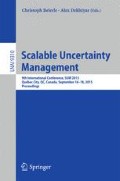Abstract
This paper deals with belief graphical models and probability-possibility transformations. It first analyzes some properties of transforming a credal network into a possibilistic one. In particular, we are interested in satisfying some properties of probability-possibility transformations like dominance and order preservation. The second part of the paper deals with using probability-possibility transformations in order to perform MAP inference in credal networks. This problem is known for its high computational complexity in comparison with MAP inference in Bayesian and possibilistic networks. The paper provides preliminary experimental results comparing our approach with both exact and approximate inference in credal networks.
Access this chapter
Tax calculation will be finalised at checkout
Purchases are for personal use only
Notes
- 1.
It is important to note that the number of extreme points can reach N! where N is the number of interpretations [16].
- 2.
- 3.
Let \(\pi '\) and \(\pi ''\) be two possibility distributions, \(\pi '\) is more specific than \(\pi ''\) iff \(\forall {{\omega }_{i}}{\in }{\varOmega }\), \(\pi '(\omega _{i})\le \pi ''(\omega _{i})\).
- 4.
In the rest of this paper, TR denotes an interval-based probability-possibility transformation satisfying the following principles:
-
Dominance: The possibility distribution \(\pi \) obtained from the IPD IP by TR dominates every probability distribution p compatible with IP, namely \(\forall {\phi } \subseteq \varOmega \), \(\pi (\phi ) \ge p(\phi )\).
-
Order preservation: Given two interpretations \(\omega _i \in {\varOmega }\) and \(\omega _j \in {\varOmega }\), \(\pi (\omega _i) < \pi (\omega _j)\) iff \(\overline{p}(\omega _i) < \underline{p}(\omega _j)\).
-
- 5.
The permutation property of probability-possibility transformations is discussed in [14].
- 6.
- 7.
References
Benferhat, S., Levray, A., Tabia, K.: On the analysis of probability-possibility transformations: changing operations and graphical models. In: ECSQARU 2015, Compiegne, France, 15–17 July 2015
Borgelt, C., Kruse, R.: Learning possibilistic graphical models from data. IEEE Trans. Fuzzy Syst. 11(2), 159–172 (2003)
Cozman, F.G.: Credal networks. Artif. Intell. 120(2), 199–233 (2000)
Darwiche, A.: Modeling and Reasoning with Bayesian Networks. Cambridge University Press, New York (2009)
Destercke, S., Dubois, D., Chojnacki, E.: Transforming probability intervals into other uncertainty models. In: EUSFLAT 2007 Proceedings, vol. 2, pp. 367–373. Universitas Ostraviensis, Ostrava, Czech Republic (2007)
Dubois, D., Foulloy, L., Mauris, G., Prade, H.: Probability-possibility transformations, triangular fuzzy sets, and probabilistic inequalities. Reliable Comput. 10(4), 273–297 (2004)
Dubois, D., Prade, H.: Possibility Theory: An Approach to Computerized Processing of Uncertainty. Plenum Press, New York (1988)
Dubois, D., Prade, H.: Random sets and fuzzy interval analysis. Fuzzy Sets Syst. 42(1), 87–101 (1991)
Klir, G.J., Geer, J.F.: Information-preserving probability-possibility transformations: recent developments. In: Lowen, R., Roubens, M. (eds.) Fuzzy Logic, pp. 417–428. Kluwer Academic Publishers, Dordrecht (1993)
Levi, I.: The Enterprise of Knowledge: An Essay on Knowledge, Credal Probability, and Chance/Isaac Levi. MIT Press, Cambridge, Mass (1980)
Masson, M.-H., Denoeux, T.: Inferring a possibility distribution from empirical data. Fuzzy Sets Syst. 157(3), 319–340 (2006)
Mauá, D., de Campos, C.P., Benavoli, A., Antonucci, A.: Probabilistic inference in credal networks: new complexity results. J. Artif. Intell. Res. (JAIR) 50, 603–637 (2014)
Slimen, Y.B., Ayachi, R., Amor, N.B.: Probability-possibility transformation: application to Bayesian and possibilistic networks. In: Masulli, F. (ed.) WILF 2013. LNCS, vol. 8256, pp. 122–130. Springer, Heidelberg (2013)
Sudkamp, T.: On probability-possibility transformations. Fuzzy Sets Syst. 51, 73–81 (1992)
Walley, P.: Towards a unified theory of imprecise probability. Int. J. Approx. Reason. 24(23), 125–148 (2000)
Wallner, A.: Extreme points of coherent probabilities in finite spaces. Int. J. Approx. Reason. 44(3), 339–357 (2007)
Zadeh, L.A.: Fuzzy sets as a basis for a theory of possibility. Fuzzy Sets Syst. 100, 9–34 (1999)
Acknowledgements
This work is done with the support of a CNRS funded project PEPS FaSciDo 2015 - MAPPOS.
Author information
Authors and Affiliations
Corresponding author
Editor information
Editors and Affiliations
Rights and permissions
Copyright information
© 2015 Springer International Publishing Switzerland
About this paper
Cite this paper
Benferhat, S., Levray, A., Tabia, K. (2015). Probability-Possibility Transformations: Application to Credal Networks. In: Beierle, C., Dekhtyar, A. (eds) Scalable Uncertainty Management. SUM 2015. Lecture Notes in Computer Science(), vol 9310. Springer, Cham. https://doi.org/10.1007/978-3-319-23540-0_14
Download citation
DOI: https://doi.org/10.1007/978-3-319-23540-0_14
Published:
Publisher Name: Springer, Cham
Print ISBN: 978-3-319-23539-4
Online ISBN: 978-3-319-23540-0
eBook Packages: Computer ScienceComputer Science (R0)

